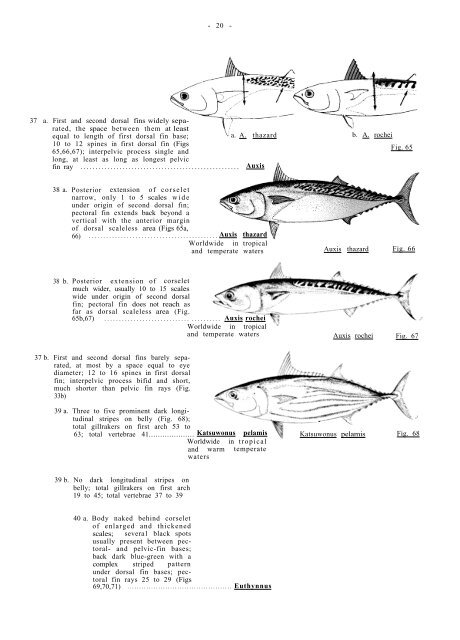FAO SPECIES CATALOGUE - si-pddr
FAO SPECIES CATALOGUE - si-pddr
FAO SPECIES CATALOGUE - si-pddr
Create successful ePaper yourself
Turn your PDF publications into a flip-book with our unique Google optimized e-Paper software.
37 a. First and second dorsal fins widely separated,<br />
the space between them at least<br />
equal to length of first dorsal fin base;<br />
1. a. A. thazard<br />
10 to 12 spines in first dorsal fin (Figs<br />
65,66,67); interpelvic process <strong>si</strong>ngle and<br />
long, at least as long as longest pelvic<br />
fin ray ...................................................... Auxis<br />
38 a. Posterior exten<strong>si</strong>on of corselet<br />
narrow, only 1 to 5 scales wide<br />
under origin of second dorsal fin;<br />
pectoral fin extends back beyond a<br />
vertical with the anterior margin<br />
of dorsal scaleless area (Figs 65a,<br />
66)) . . . . . . . . . . . . . . . . . . . . . . . . . . . . . . . . . . . . . . . . . . . . Auxis thazard<br />
Worldwide in tropical<br />
and temperate waters<br />
38 b. Posterior exten<strong>si</strong>on of corselet<br />
much wider, usually 10 to 15 scales<br />
wide under origin of second dorsal<br />
fin; pectoral fin does not reach as<br />
far as dorsal scaleless area (Fig.<br />
37 b. First and second dorsal fins barely separated,<br />
at most by a space equal to eye<br />
diameter; 12 to 16 spines in first dorsal<br />
fin; interpelvic process bifid and short,<br />
much shorter than pelvic fin rays (Fig.<br />
33b)<br />
39 a. Three to five prominent dark longitudinal<br />
stripes on belly (Fig. 68);<br />
total gillrakers on first arch 53 to<br />
63; total vertebrae 41.....................Katsuwonus pelamis<br />
39 b. No dark longitudinal stripes on<br />
belly; total gillrakers on first arch<br />
19 to 45; total vertebrae 37 to 39<br />
- 20 -<br />
65b,67)) . . . . . . . . . . . . . . . . . . . . . . . . . . . . . . . . . . . . . . . . Auxis rochei<br />
Worldwide in tropical<br />
and temperate waters<br />
Worldwide in tropical<br />
and warm temperate<br />
waters<br />
40 a. Body naked behind corselet<br />
of enlarged and thickened<br />
scales; severa1 black spots<br />
usually present between pectoral-<br />
and pelvic-fin bases;<br />
back dark blue-green with a<br />
complex striped pattern<br />
under dorsal fin bases; pectoral<br />
fin rays 25 to 29 (Figs<br />
69,70,71) . . . . . . . . . . . . . . . . . . . . . . . . . . . . . . . . . . . . . . . . . . . . Euthynnus<br />
b. A. rochei<br />
Fig. 65<br />
Auxis thazard Fig. 66<br />
Auxis rochei Fig. 67<br />
Katsuwonus pelamis Fig. 68
















